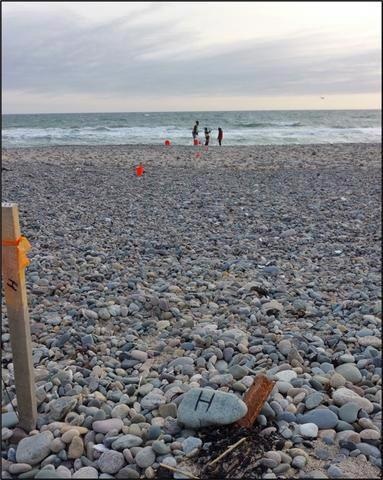Jun 22 2021
This summer, millions of Americans will visit the beaches in New England to play in the waves, soak up the sun and simply cool off. To date, the factors that govern which beaches slope slowly to the sea and which ones end suddenly in a steep drop-off, have been largely vague.
 Woodruff’s team making a transect of a rocky New England Beach. Image Credit: Jon Woodruff.
Woodruff’s team making a transect of a rocky New England Beach. Image Credit: Jon Woodruff.
Now, a new study performed by the University of Massachusetts Amherst (UMass Amherst) has revealed, with unparalleled detail, the relationship between the grain size of the beach sand and the slope of the beach itself. These results are crucial to understanding how the beaches in New England would respond to both increased storm activity and rising sea levels.
Most of the beaches in New England contain a mixture of small stones and sand. Specifically, the grain sizes on these beaches are “bi-modal” — that is, made up of very large pieces of gravel, measuring 10 to 64 mm, and medium-to-coarse sand, measuring 0.25 to 1 mm, but with very little in between.
I challenge you to find a handful of grains from a New England beach that are about 5 millimeters (or just under one-quarter of an inch) in diameter. There just aren’t many.
Jon Woodruff, Study Lead Author and Professor, Department of Geosciences, University of Massachusetts Amherst
The study was recently published in the Marine Geology journal.
Grain size is an important determinant of a beach’s slope. Scientists have known for a long time that if the sand is finer, the beach will be pitched more gradually — up to a point. “The relationship between grain size and slope falls apart for coarser-grained beaches” added Woodruff. Many beaches in New England generally contain coarse-grained particles but they slope gradually to the edge of the water. Up until now, the reason was unknown.
Past researchers have always focused on either the mean or median grain size.
Jon Woodruff, Study Lead Author and Professor, Department of Geosciences, University of Massachusetts Amherst
This method works well for finer-grained beaches; however, in the case of a bi-modal New England beach, the median grain size falls directly in that gap from 1 to 10 mm. Woodruff and his colleagues collected more than 1000 samples from 18 beaches in Massachusetts and assembled the largest, publicly available dataset on New England beaches.
The research team from UMass Amherst also included Steve Mabee and Nick Venti from the Massachusetts Geological Survey, along with a large group of students headed by UMass co-authors Doug Beach and Alycia DiTroia.
The research team headed by Woodruff discovered that in bi-modal beaches, the finer-grained sand determined the slope of a beach. Woodruff added, “That smaller handful of sand grains is why beachgoers have a place to sunbathe in New England.”
The study was performed in association with the Massachusetts Office of Coastal Zone Management and funded by the federal Bureau of Ocean Energy Management and the Northeast Climate Adaptation Science Center. It has implications far beyond the next summer vacation.
Understanding how beach sand grain size influences the makeup of our beaches is critical for making projections as to how beaches will respond to storms and sea-level rise. Especially given the attempts to preserve beaches from erosion, which cost many millions of dollars every year, we need to know what determines the shape and defining grain size characteristics of these beaches.
Jon Woodruff, Study Lead Author and Professor, Department of Geosciences, University of Massachusetts Amherst
Journal Reference:
Woodruff, J. D., et al. (2021) Grain size and beach face slope on paraglacial beaches of New England, USA. Marine Geology. doi.org/10.1016/j.margeo.2021.106527.